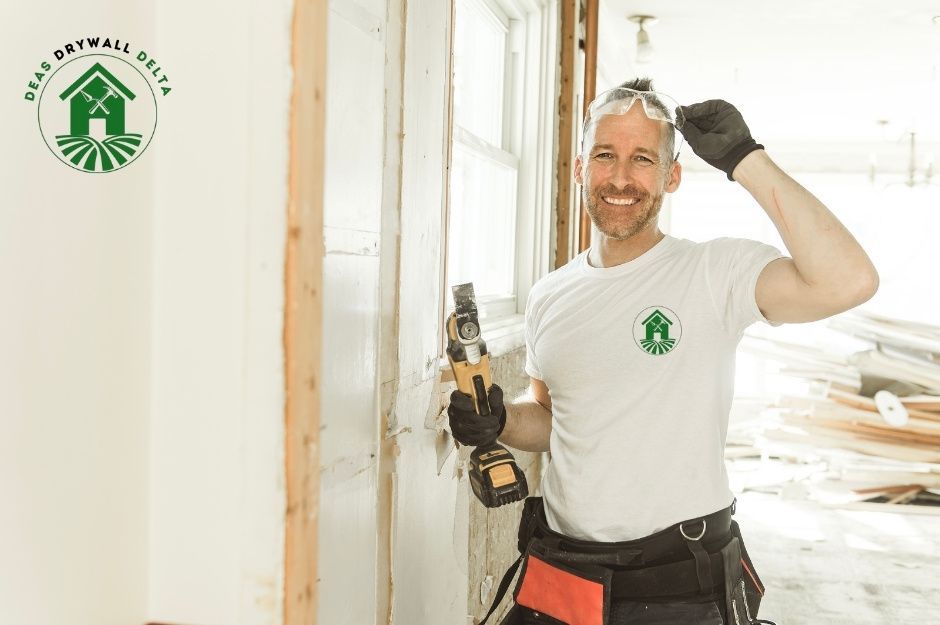Drywall Repair Richmond
High-quality Sheetrock Repair Company in Richmond, BC | Sheetrock Repair Pros

Maintaining your home's walls and ceilings is crucial for both aesthetics and structural integrity. When you notice cracks, holes, water damage, or aging popcorn texture in your Richmond, BC property, professional drywall repair services at Deas Drywall Delta can restore your surfaces to pristine condition.
Local Richmond drywall contractors offer comprehensive solutions including hole patching, crack repair, water damage restoration, popcorn ceiling maintenance, and complete drywall installation services - all backed by experienced teams who understand the unique challenges of British Columbia's climate and building standards. Given Richmond's location on Lulu Island at just one meter above sea level and surrounded by Fraser River distributaries, moisture control is particularly critical for drywall installations in this Metro Vancouver municipality of 229,781 residents.
Your drywall issues deserve prompt attention from qualified professionals who use proper techniques and materials. From minor repairs like patching nail holes to major renovations involving ceiling replacements, Richmond's drywall experts bring the skills and equipment needed to deliver lasting results that protect your investment. With Richmond's oceanic climate receiving 30% less rainfall than neighboring Vancouver, homeowners still face unique moisture challenges due to the city's high groundwater table and delta location.

Deas Drywall Delta (CP)

Comprehensive Drywall Repair Services in Richmond, British Columbia
Professional drywall repair services in Richmond address a wide range of damage types, from small holes to major water damage. Local contractors use specialized tools and techniques to restore walls and ceilings to their original condition. Richmond's diverse communities across its sixteen areas—from City Centre to Steveston's historic fishing village—each present unique architectural challenges that experienced contractors understand.
Patching Holes in Drywall
Small holes from picture hooks or wall anchors need simple patching with joint compound and sanding. Larger holes require drywall patches cut to size and secured with drywall tape.
For medium-sized holes, you'll need mesh tape around the edges to prevent future cracking. Professional contractors use a three-coat process: base coat, fill coat, and finish coat.
The repair process typically takes 24-48 hours to complete due to drying time between coats. Matching the existing wall texture ensures seamless repairs that blend with surrounding areas. In Richmond's older homes, particularly in established neighborhoods like Thompson and Hamilton, contractors often encounter vintage drywall materials that require specialized matching techniques.
Ceiling Crack and Damage Restoration
Ceiling cracks often result from house settling or temperature changes. Early repair prevents further damage and potential safety hazards. Richmond's location on alluvial soil makes homes particularly susceptible to settling, especially in areas like Fraser Lands and East Richmond where the soft delta soil can shift over time.
Professional repair teams use fiber-reinforced compounds for enhanced durability. The process involves cleaning the crack, applying joint tape, and multiple layers of compound.
Water-damaged ceilings require immediate attention to prevent mold growth. Contractors first identify and fix the water source, then remove damaged material before installing new drywall. Given Richmond's proximity to the Fraser River and surrounded by dyke systems, basement and lower-level ceiling repairs often involve moisture mitigation strategies specific to below-sea-level living.
Popcorn Ceiling Texture and Damage Solutions
Damaged popcorn texture requires careful repair to match existing patterns. Contractors first test for asbestos in older homes before beginning repairs. Many of Richmond's homes built during the township's rapid growth after its 1879 incorporation may contain asbestos, particularly in areas like Steveston and Broadmoor where historic buildings are common.
The repair process includes:
- Scraping damaged areas
- Applying new base coat
- Matching existing texture
- Blending edges with surrounding areas
For water-stained popcorn ceilings, professionals apply stain-blocking primer before new texture application.
Corner Bead and Joint Repairs
Corner bead damage often occurs from impact in high-traffic areas. Metal or vinyl corner beads provide durability and clean lines at wall corners.
Joint repairs require proper taping technique to prevent future cracking. Professional contractors use paper tape for stronger joints, especially in areas with movement. Richmond's building height restrictions of 150 feet due to Vancouver International Airport proximity mean most residential properties have multiple joints in standard ceiling heights that require expert finishing.
The repair process includes:
- Removing damaged material
- Installing new corner bead or tape
- Applying multiple compound layers
- Careful sanding between coats
Drywall Installation: Methods and Benefits
Professional drywall installation creates sturdy, well-insulated walls while providing excellent noise reduction and moisture control. Modern installation techniques combine proven methods with innovative materials to deliver superior results. With Richmond's significant East Asian Canadian population comprising three-fourths of residents, contractors often work with diverse architectural styles from traditional Canadian builds to contemporary Asian-influenced designs.
Professional Drywall Installation Process
Your drywall project starts with accurate measurements and proper framing inspection. Professional installers check stud spacing and ensure electrical boxes are correctly positioned.
Sheets are cut precisely to fit your space, with careful attention to doorways, windows, and corners. Professionals use specialized lifts for ceiling installation to ensure perfect alignment.
The fastening process requires specific screw patterns and depths to prevent future popping or sagging. Quality installers apply corner beads to protect edges and create clean lines. Richmond's seismic activity risk due to its Fraser River delta location requires specialized fastening techniques to accommodate potential ground movement.
Residential and Commercial Installation
Your home installation needs differ from commercial projects in material thickness and fire ratings. Residential spaces typically use 1/2-inch drywall, while commercial projects often require 5/8-inch fire-rated panels.
Professional teams adapt their techniques based on your space requirements. Homes need careful attention to detail around fixtures and cabinets. In Richmond's City Centre high-rise developments and Sea Island commercial areas near YVR airport, contractors must meet stringent fire codes and sound dampening requirements.
Commercial installations focus on meeting building codes and fire safety standards. Large-scale projects require strategic planning for expansion joints and extended wall heights.
Moisture and Soundproofing Solutions
You can enhance your space with specialized drywall types. Moisture-resistant panels protect bathrooms and basements from water damage. Richmond's high groundwater table means very few homes have basements, but those that do require exceptional moisture barriers and specialized drywall materials.
Soundproofing options include double-layer installation and sound-dampening compounds between sheets. This creates effective barriers between rooms or units. Properties near Richmond's busy transportation corridors—including Highway 99 connecting to Interstate 5 and Highway 91—benefit significantly from enhanced soundproofing installations.
Professional installers can recommend specific materials based on your needs. Green board works well in humid areas, while Type X drywall offers enhanced fire resistance.
Proper installation of these specialized materials requires specific techniques and tools. Expert teams understand the importance of sealed joints and proper ventilation in moisture-prone areas.
Finishing and Enhancing Your Drywall
Professional drywall finishing transforms raw sheetrock into smooth, attractive walls ready for paint or other decorative treatments. The right techniques and attention to detail make a significant difference in your final results.
Joint Taping and Seamless Mudding
Start by applying paper or mesh tape over all drywall joints and corners. Press the tape firmly into a thin layer of joint compound to ensure proper adhesion.
Apply three coats of joint compound, feathering each layer wider than the previous one. The first coat should be 4-6 inches wide, the second 8-10 inches, and the final coat 12-14 inches.
Let each coat dry completely before sanding lightly between applications. Pay special attention to inside corners and areas around electrical boxes. Richmond's mild oceanic climate with average temperatures ranging from 4°C in winter to 18°C in summer provides optimal drying conditions for joint compound curing.
Pro tip: Use setting-type compound for the first coat and ready-mixed compound for subsequent layers.
Texturing and Painting the Final Surface
Choose from several texture options to match your existing walls:
- Orange peel (light spray texture)
- Knockdown (flattened spray texture)
- Smooth finish
- Custom patterns
Prime all surfaces with a high-quality drywall primer before applying texture. This ensures even absorption and proper texture adhesion.
Apply texture using specialized spray equipment or hand tools, maintaining consistent pressure and pattern throughout the application. Richmond's diverse architectural heritage, from the historic Agricultural Hall and Minoru Chapel to modern developments in Bridgeport, requires contractors skilled in matching both traditional and contemporary texturing styles.
Skim Coating and Sanding for Smooth Results
Begin with a thin layer of all-purpose joint compound across the entire surface. Use a wide drywall knife to apply compound evenly.
Sand between coats with 150-grit sandpaper, followed by 220-grit for the final pass. Use a sanding pole for ceilings and high areas.
Wipe surfaces with a slightly damp cloth to remove dust before painting. Check your work under strong lighting to spot any remaining imperfections.
Important: Wear appropriate dust protection while sanding and maintain good ventilation in your work area.
Specialized Drywall Solutions for Unique Challenges
Professional drywall contractors employ specialized techniques and tools to tackle complex repair scenarios that require precise attention to detail and extensive expertise. Richmond's unique geography as an island municipality surrounded by dyke systems presents contractors with specialized challenges requiring local expertise and understanding of delta soil conditions.
Addressing Water Damage and Mold
Water damage requires immediate attention to prevent mold growth and structural deterioration. Your first step is identifying and fixing the water source before any repairs begin.
Professionals use moisture meters to detect hidden water pockets within walls and ceilings. These tools help determine the full extent of the damage. Richmond's risk of flooding during high Fraser River spring freshets and potential dyke rupture during earthquakes makes water damage assessment particularly critical for island residents.
The repair process involves removing all compromised drywall material, treating the affected area with antimicrobial solutions, and installing new moisture-resistant drywall.
Key repair steps:
- Remove wet insulation and damaged drywall
- Install ventilation systems to dry the area
- Apply mold-resistant primers
- Replace with water-resistant drywall panels
Popcorn Ceiling Removal Techniques
Popcorn ceiling removal demands careful preparation to protect your floors and walls. The process starts with testing the texture for asbestos, particularly in homes built before 1980. Many Richmond properties from the township era following 1879 incorporation through the mid-20th century expansion may contain asbestos materials requiring specialized handling.
Removal process:
- Cover all surfaces with plastic sheeting
- Spray small sections with warm water
- Scrape texture using specialized tools
- Sand the surface smooth
Professional contractors use vacuum-attached sanders to minimize dust spread throughout your home. After removal, they apply a smooth finish or modern texture according to your preferences.
Custom Repairs for Plaster and Textured Surfaces
Matching existing textures requires skill and specialized tools. Your contractor will analyze the original pattern and create custom mixing ratios to achieve the perfect match.
Different texture types need specific application methods:
- Knockdown: Spray application followed by light flattening
- Orange peel: Fine spray pattern application
- Swirl: Hand-troweled circular patterns
Professionals use small test areas to perfect the texture match before applying it to the entire repair zone. This ensures seamless integration with your existing wall or ceiling surface. Richmond's heritage sites like the Gulf of Georgia Cannery and Britannia Shipyard National Historic Site showcase traditional building techniques that contractors must carefully preserve when performing repairs on historic structures.
